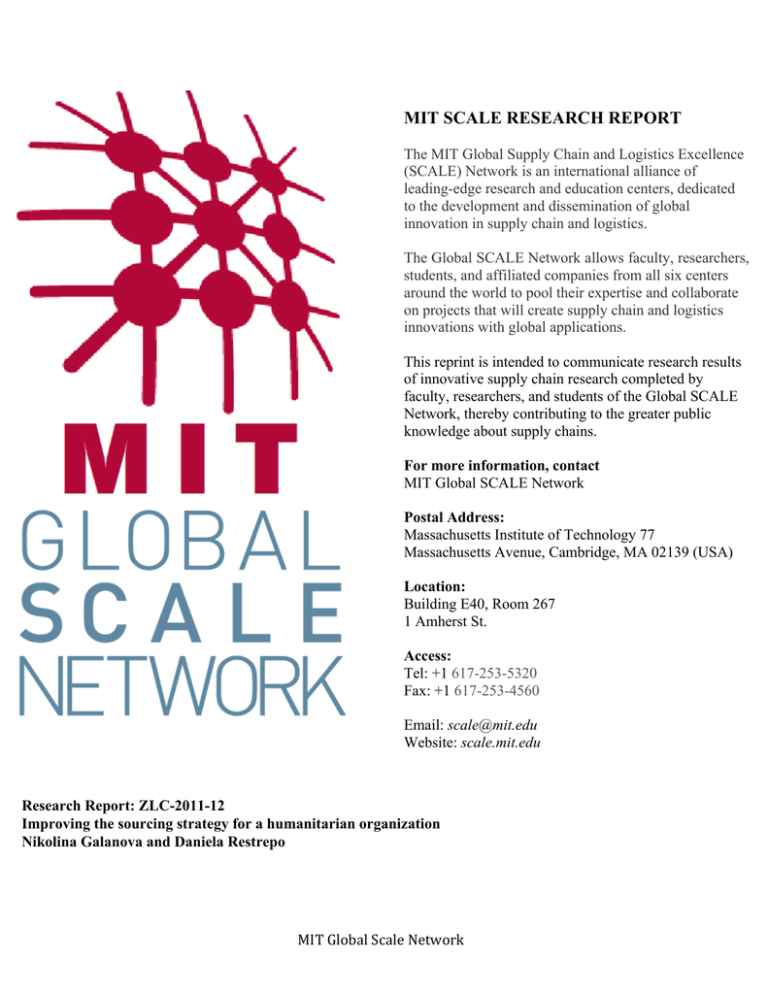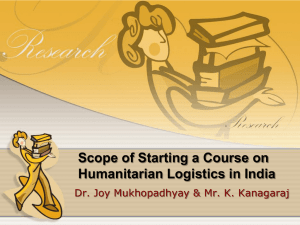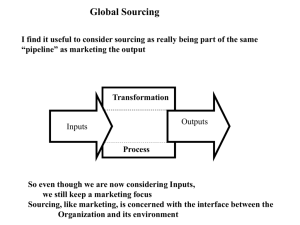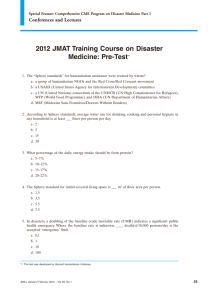MIT SCALE RESEARCH REPORT
advertisement

MIT SCALE RESEARCH REPORT The MIT Global Supply Chain and Logistics Excellence (SCALE) Network is an international alliance of leading-edge research and education centers, dedicated to the development and dissemination of global innovation in supply chain and logistics. The Global SCALE Network allows faculty, researchers, students, and affiliated companies from all six centers around the world to pool their expertise and collaborate on projects that will create supply chain and logistics innovations with global applications. This reprint is intended to communicate research results of innovative supply chain research completed by faculty, researchers, and students of the Global SCALE Network, thereby contributing to the greater public knowledge about supply chains. For more information, contact MIT Global SCALE Network Postal Address: Massachusetts Institute of Technology 77 Massachusetts Avenue, Cambridge, MA 02139 (USA) Location: Building E40, Room 267 1 Amherst St. Access: Tel: +1 617-253-5320 Fax: +1 617-253-4560 Email: scale@mit.edu Website: scale.mit.edu Research Report: ZLC-2011-12 Improving the sourcing strategy for a humanitarian organization Nikolina Galanova and Daniela Restrepo MITGlobalScaleNetwork For Full Thesis Version Please Contact: Marta Romero ZLOG Director Zaragoza Logistics Center (ZLC) Edificio Náyade 5, C/Bari 55 – PLAZA 50197 Zaragoza, SPAIN Email: mromero@zlc.edu.es Telephone: +34 976 077 605 MITGlobalScaleNetwork Improving the sourcing strategy for a humanitarian organization By Nikolina Galanova and Daniela Restrepo Thesis Advisor: Prashant Yadav Summary: This thesis focuses on how sourcing strategy affects the success of a relief operation during the first 48 to 72 hours in the aftermath of a disaster. The suggested sourcing model is built upon implementations adopted by other aid agencies and by a thorough analysis and improvement opportunities of their current processes and flows. Nikolina Galanova graduated from the ZLOG program in 2011. She is an experienced logistics professional with a strong background in assisting government, private and humanitarian organizations for 13 years. Nikolina received her B.A. in Finance from Veliko Turnovo University, Bulgaria, in 2001. KEY INSIGHTS 1. During emergencies, the biggest waste in process is time. While confusion and chaos bring inefficiencies during relief operations, the organization tends to be more activity than process focused. 2. There is an opportunity in defining the sourcing strategy where trade-offs between cost, lead time and qualities are the major issues to identify and establish. 3. Lack of a disaster preparedness strategy focusing on inventory pre-positioning impairs the organization in the immediate aftermath of a disaster. Introduction When a disaster strikes, people’s lives are disrupted abruptly. The increasing complexity of disasters has forced international humanitarian organizations to enhance their strategy in achieving the ultimate goal of purchasing, that is, to deliver the needed supplies at a fair price to the disaster site as soon as possible. In other words, having the right sourcing strategy in place translates into a more efficient Daniela Restrepo graduated from the ZLOG program in 2011. She is currently working as consultant and trainer at LOGyCA, Colombia, and has been working in the field for 11 years. Daniela received her B.Eng. in Production Engineering from Universidad EAFIT Medellin, Colombia. in 2000. emergency response operation allowing the affected population to quickly assume normalcy in their daily routine. Thomas (2003) describes logistics as central to disaster relief for several reasons. First, it serves as a bridge between disaster preparedness and response, between procurement and distribution, and between headquarters and the field. Second, it is crucial to the effectiveness and speed of response for major humanitarian programs, such as health, food, shelter, water and sanitation. Third, since the logistics department handles tracking of goods through the supply chain, it is often the repository of data that can be analyzed to provide post-event learning. While logistics can be one of the most expensive characteristics of the relief operation, logistics data reflects all aspects of execution, from the effectiveness of suppliers and transportation providers, to the cost and timeliness of response, to the appropriateness of donated goods and the management of information. Building a well-structured sourcing strategy is key to the overall success of the emergency response plan that international humanitarian organizations aim at establishing as a pre-requisite for maximizing their response coverage and minimizing the lead time. Logistics is inevitably linked to the sourcing tactics behind it. Referred to as a back-office function in the past, logistics - and humanitarian logistics in particular - is considered the backbone in disaster relief operations. For example, the decision on prepositioning relief supplies or post-disaster procurement to meet the critical needs in the first 48 to 72 hours following the disaster, has a direct effect on the associated logistics costs, suppliers’ lead times and capacity, customs clearance, handling and storage, and ultimately is reflected in the ability to save human lives. How can a humanitarian organization select a sourcing strategy that has a strategic fit with its mission and is financially sustainable within its budget constraints? It was the purpose of this thesis project to suggest an improved sourcing strategy during emergency response and complement it with the possibility of stock pre-positioning and long-term agreements with suppliers. Methodology to address task/ situation The international humanitarian organization supporting this thesis project is among the leading agencies helping the most vulnerable during disasters and complex emergencies. The methodology employed follows the steps as described below: Stages Research Data Collection Current Process Mapping Data Anlysis and Model Building to attain a more comprehensive overview of the organization’s strategy, including the process advantages and disadvantages. Current Process Mapping Analysis of the entire supply chain - its flow and structure - was conducted to fit it within the organization’s strategy. The impacts of trade-offs between the main variables were considered here. Additionally, disaster preparedness and response mechanisms that other relief agencies employ were studied further in greater detail to consider possible integration in the proposed strategy and to understand how one of the main performance criteria – lead time - is minimized to be successful during the emergency response phase. Data Analysis and Model Building The findings and conclusions derived from the preceding stages were taken into account to evaluate the supply chain process starting from the moment a disaster strikes all the way through to the delivery of supplies to beneficiaries, incorporating recommendations and improvement opportunities. The organization’s current sourcing strategy illustrated below is divided into two phases with Phase 1 giving an overview of the immediate 48 to 72 hours following a disaster, and Phase 2 outlining the process from the purchase requisition authorization to the delivery of relief supplies at the destination. Both Phase 1 and Phase 2 are interrelated with external partners, organizations and companies with a strong emphasis on interactions with governments, the military, donors and partner agencies focusing on disaster coordination during the first part, and communication and collaboration with vendors and beneficiaries all through the second part. Alliances with partner aid agencies are present throughout the whole supply chain network. Research This very first step of the methodology discusses literature research and review focusing on the humanitarian logistics field, operations, procurement, planning, strategy, modeling, simulations and disasters. In the ever-growing market of humanitarian emergency response, the need to enhance the sourcing strategy of a humanitarian organization during emergencies will give a competitive advantage and increase the opportunity to be among the first ones on the ground in the immediate aftermath of a disaster. Data Collection The second part consists of interviews conducted at the Pakistan mission with employees of the organization. A questionnaire specifically developed to assess the aspects of the supply chain was used Disaster strikes Quoting process Analysis/ Procurement decision Government dimesions Purchase requisition Purchase order Assesment team on the ground Budget preparation and authorizations Assesment report with needs Coordination with donors and budget funding Conclusions Delivery In this study, we took as a model the sourcing strategy the organization employs in their Pakistan mission, assuming that the sourcing model in this country office is a replica of the global sourcing approach the organization implements in their missions worldwide. While we recognize that the organization bases operations on activities and not on processes, we joined the activities into processes to assess them and consolidate the suggested improvement opportunities. These recommendations are all based on the five humanitarian supply chain challenges we have chosen: Coordination, Staff, Information System (Technologies), Performance Indicators and Uncertainty. When evaluating a process, the following questions must be answered: • How is the process done? • How should it be done? • What are the gaps between the first two queries? These gaps were found mostly in areas such as strategy definition and communication, coordination inside and outside the organization, network design and preparedness, trade-off definitions, and results measurement for building enhanced actions. Following our assessment of the organization’s current sourcing strategy during emergency response, we outlined an inventory-prepositioning plan that we found feasible for the organization to introduce and incorporate into their existing policies and procedures to improve the success of their relief operations. Naturally, the next question that came up was the quantity of relief supplies or how much inventory to pre-position. This value would depend on variables like the demand, lead time, fill rate, the desired beneficiaries/donors service level, and the resources available. Prepositioning also implies the consideration of a decentralized supply chain system, extensively described throughout the project. In addition to the conclusions found from our study, we believe it is appropriate to raise some general recommendations for future consideration and research as outlined at the end of our thesis. The suggestions include building performance systems and control, evaluation and improvement of internal and external procedures, an in-depth study of a prepositioning strategy in collaboration with other aid agencies, and a development plan for the information technologies in place.





